NALSAROVAR : THE PRIDE OF GUJARAT ON VERGE OF
LOSING GLORY
--A S Bishnoi and Shakti Bishnoi
1. The Nal Sarovar Lake is in a lowest-lying area between the Central Gujarat and East Saurashtra and is a Bird Sanctuary, spread in the area of 120.82-sq-km Lake, a serene marshland with shallow waters (4-5 ft) which contains 36
small islands. Nalsarovar-Ahmedabad distance is about 60 km located near Sanand Village, in Gujarat. Mainly inhabited by migratory birds as their wintering ground. Nalsarovar wetland is the largest wetland bird sanctuary in Gujarat, and one of the largest
in India. Nalsarovar is a Bird Sanctuary since April 1969 and also a Ramsar site since 24 September 2012.
2. More than 200 types of birds mainly waterfowl inhabit this lake and come from as far as Siberia. Nalsarovar in Gujarat is a bird watcher’s paradise, one can find rosy pelicans, lesser and greater flamingos, crakes, brahminy ducks, purple moorhen, herons,
white storks, various species of bitterns, grebes etc in the lake. Best time to visit Nalsarovar is in winter between November to February. However, migratory birds starts arriving in October and stay until April but their population reaches its peak in mid
winter.
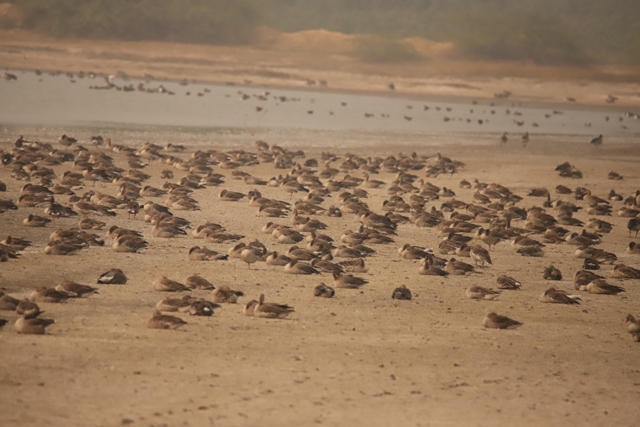
Garganey and spotted bill ducks resting
3. We were en-route to Ahmedabad from Gir Sanctuary and Nalsarovar was one of the destination I wanted to halt and make my daughter see flamingoes and other migrants. So we took diversion from National Highway and headed towards Nalsarovar. The last
visit to this paradise of birds was in 2004 and now after 15 years I am visiting along with my extended family members. Daughter and my wife were equally excited. We were short of 10 km from Nalsarovar , we spotted Sarus Crane family, all time favourite
to watch them and this time with young one as a family. We clicked few photos and as day was coming to an end, we headed straight to Nalsarovar. One of the surprising thing I noticed was locals have maintained strict cleanliness policy and one can find the
water so clean that u can clearly see the sheval plants grown inside the lake. Sheval plant is food to the birds as well as the fish inside the lake.
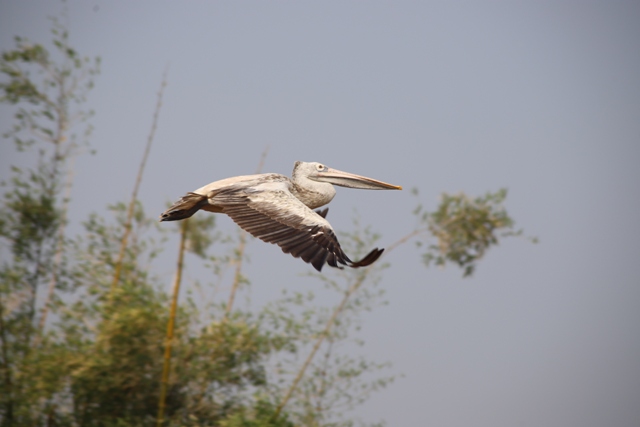
Pelican
4. Generally guide charges are Rs. 400 to Rs. 500 but as we both are ornithologists (We attended course from BNHS, RISHI valley, ELA foundation) and visited several bird sanctuaries, we headed directly to interiors of village and took responsibility on
us to teach our daughter. I am well versed with Gujarati so I could converse and found our way to reach the point where, paradise is just to be felt. The best time to reach there is just before sunrise as the lake is calm and quiet and flocks of birds having
their food or sunset if you have specific thing in mind to click the particular photo.
5. We sat near the sand dune to make us not visible to flock of birds enjoying their food. We took our positions and slowly marched ahead like Army person crawling to have the first glimpse of Flamingos. They are shy and with little disturbance, they
fly and it becomes difficult to sight them. We saw first flock and it was amazing sight with our binoculars and then I took out my camera to click them. That day was cloudy and it was boon for eyes, but photos were not as against the blue sky background. Still
managed to click few and headed towards the other end to have a closer look. To my surprise, there was drastic reduction in birds count. Lot of land nearby lake was converted into irrigation land /encroachment and water being continuously pumped regularly
for the cash crops in and around the lake. Extensive exploitation of water for personal usage and finally our guests i.e birds suffer. With our little brain we are yet realize that we are because of them. There was a time, if little disturbance near the lake
being sensed by birds, the sky was dark with blanket of birds around you. But now after a decade, the picture painted by migrants is different. They are not happy or comfortable with the existing mind set of humans and governance also. I even visited THOL,
the birds count in Thol was more than the Nalsarovar..it is stark reality.
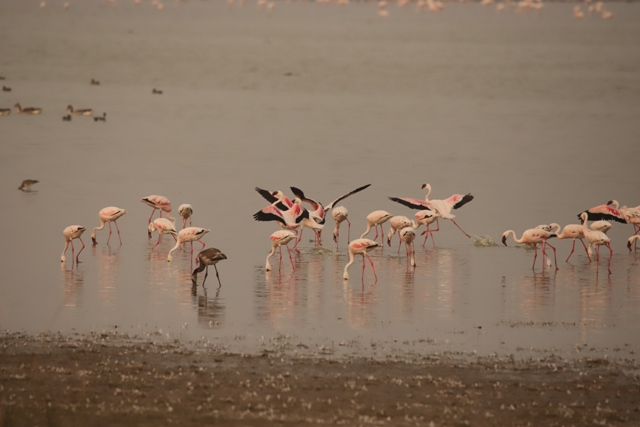
Flamingos
6. Nalsarovar wetland is facing a tough competition by another nearby wetland named Thol. Birds count in Thol is almost double the Nalsarovar. Estimated number of birds per sq km in Thol is around 9000. While in Nalsarovar is only approx 2500 birds per
sq km and the most birds are local and not migratory.
The reasons are many but prominent are as appended below:-
(a)Fishing. Extensive fishing by locals as their livelihood.
(b) Poaching. Poaching in today era by the locals has major role in scaring birds away from Nalsarovar sanctuary. Everyone is aware of this fact till up the governance. Poachers lay nets to trap exotic birds of Nalsarovar, Gujarat. It is a bitter truth
that locals of at least 15 surrounding villages are (said to be) involved in illegal fishing and poaching activities. Only seven to eight foresters and guards combined safeguards Nalsarovar. Locals take advantage of this staff scarcity to poach birds and sell
them into the black market.
(c) Lack of Guards at Lake. Ideally, for every 10 sq km there should be one person to guard the lake. Nalsarovar’s guard count should be of eight guards, six foresters and two rangers but these posts remain unfilled since long. Moreover, there are some
watchtowers but the guards lacks the basic equipment such as binoculars. Nalsarovar Forest department also lack adequate boats and are not the expert enough rovers to chase the poachers.
(d) Narmada Water. Diversion of excess Narmada waters to Nalsarovar Lake. This is happening since the past few years is probably another reason for it. The excess Narmada water in Nalsarovar Lake has altered water quality of the marshland and has led
to consistently high levels of water in Nalsarovar. It is a turnoff for migratory birds. Especially the birds like greater and lesser flamingos that thrive in shallow waters of about 2ft, which Nalsarovar once used to be. The water is for irrigation, to earn
at the expense of life of migratory birds.
(e) Thol the Competitor : It is an artificial lake near Thol village in Kalol area of Mehsana District in Gujarat, India. It is a reservoir made for irrigation in 1912. It is a fresh water lake same as Nalsarovar and is a marshland. Thol is a Bird Sanctuary
since the year of 1988.
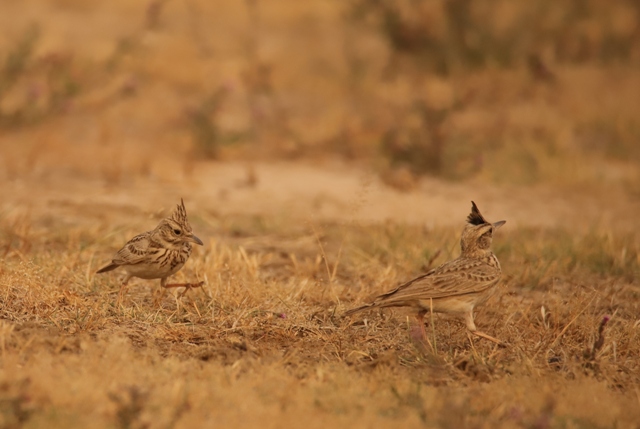
Crested Larks
Urgent Actions Required to Regain Glory
7. The grass inside the Nalsarovar Lake is more than 10 feet high. And it is easy for a person to hide behind it and go undetected. One of the solutions is to trim the grass. Trimming the grass is so effective that this alone can make life difficult for
the poachers.
8. Nalsarovar forest department can only take care of the few things. It is time the government does something for the people who live in and around Nalsarovar sanctuary. Blame is on Padhar community that lives in villages around the sanctuary and Nalsarovar
city for Poaching in Nalsarovar, Ahmedabad. It is also a fact that from centuries they have killed the birds for food and business. It is difficult for them to leave their way-of-life and stop without the government providing them with parallel lifestyle.
9. Nalsarovar Forest department had plans to grade the boatmen based on their education and the quality of service they provide. For example, one grade of boatmen, would only offer exclusive services to big groups like schools. But the authorities did
nothing after a single guide-training program. Most of the guides are poor but educated and unemployed, providing them with a job opportunity would have ensured that they do not indulge in poaching activities.
The classic example is Chilika should be followed where erstwhile poachers became the savior and guides with enough to earn for their livelihood in just four months. Chilika model should be adopted for overall success.
10. Creating in-depth awareness by government/forest officials or campaign by and NGOs to explain the importance of Nalsarovar and impact on environment will bring everlasting change. The change has to start from lower level and it will be boon for migratory
birds and once gain they will revisit to Nalsarovar. For generations it gets registered in their brain and once it is fixed, it will be too late. Chilika took one decade to gain its glory. We need to start now before the fusing of data in their brain (migratory
birds) takes place. It is do or die situation now or never. Our next generation will only read in books about Nalsarovar..like Harappa and Mohenjedaro…so action is needed today.
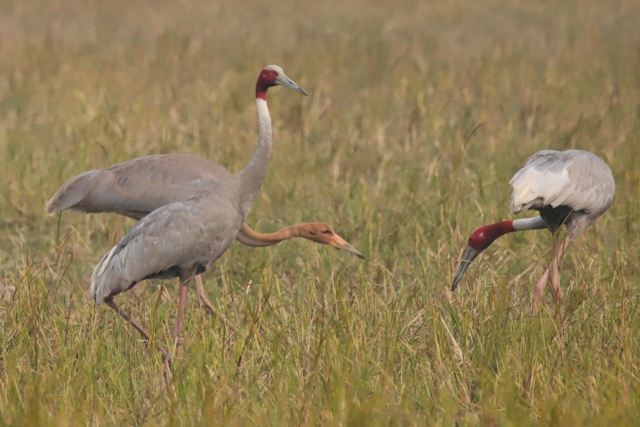
Sarus Cranes
Mr A S Bishnoi is a post graduate in Electronics. Apart from wildlife photography, he is qualified ornithologist and has been contributing by participating in bird census of Chilika lake for the last 10 years and also BNHS related activities.
Mrs Shakti Bishnoi is a postgraduate from London School of Business Management. She is qualified and experienced ornithologist, participates in bird census and child counselor. Believes in increasing green cover and has taken initiative at ground level.
Marathon runner for a cause.